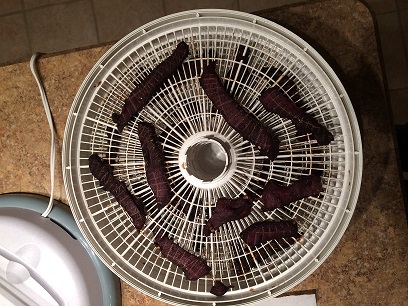Venison Jerky
- Details
- Published: Sunday, 27 December 2015 01:03
- Written by David DeCiero
My brother had an exceptionally good year hunting, taking down 3 large deer. This left him with an abundance of venison, of which I happily allowed him to use my freezer. In the course of the storage, some of the meat was “lost.” One of the things that did find it back to him was some venison jerky. I only make jerky from steak, since the ground meat version is too fatty and doesn’t have the same chewiness that makes jerky so good. So, I dug out my favorite jerky recipe, my dehydrator and 2 pounds of venison steak.
The first thing is to make sure that the meat has been frozen for 30 days. This is to ensure that any parasites or microrganisms in the venison is killed. Honestly, I find it interesting that we think wild game is more contaminated than the factory farmed cow, but it is what it is. The next thing is to have the meat not totally thawed out. Having it semi-frozen allows for better cutting. This ensures that I can cut each piece as closely to ¼” thick as possible. The uniform thickness allows for an even drying amongst all the pieces. I have found about 8 hours in my fridge from the freezer gets me to the right state of frozenness. I then mix up the following marinade for 2 lbs of meat:
2/3 cup Worcestershire sauce
2/3 cup soy sauce
1 tablespoon honey
2 teaspoons freshly ground black pepper
2 teaspoons onion powder
1 teaspoon liquid smoke
1 teaspoon red pepper flakes
After mixing all of the ingredients together, I put it and the sliced meat in a resealable bag for 4 hours in the refrigerator. After four hours, I pull it out of the fridge and place it on the dehydrator trays. I put a lot of space between the pieces to make sure I have good airflow. I then set it to 160 F and walk away for 2 hours. After 2 hours, I take the dehydrator apart and pat down the pieces to absorb any fat. Venison is so lean that it rarely has any, but beef has a tiny bit, so it’s a force of habit. (If you make it from ground meat, you’ll be doing this frequently). I then restack the trays in the opposite order (top one is now on the bottom) to make sure I get evenness and then restart it for another 2 hours. After that, I repeat the pat down and restacking before another 2 hours of cooking. In the winter, when the air is dryer, 6 hours is all that is needed to dry my jerky. You can tell when it is done because the strips are had but still bendable, with no pockets of moisture. I then place it into resealable bags and toss it in the freezer. The best part is that you can eat it right out of the freezer since there is no moisture in it. It just helps to ensure that I don’t have to worry about it going bad in a month. That way, if I forget about it, I don’t ends up having to throw it away. The whole process takes the course of 1 day, so it isn’t too hard to plan.





